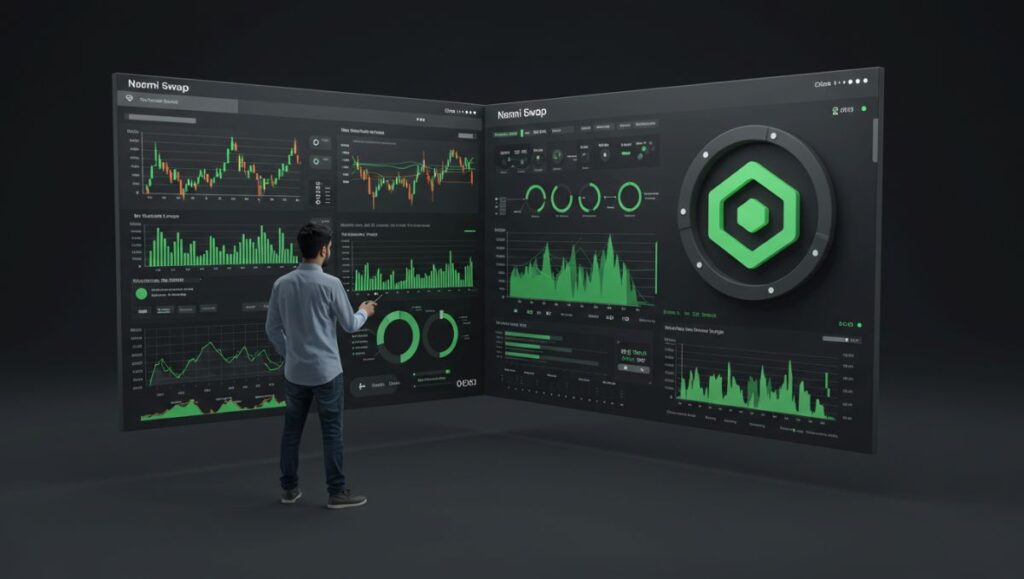Blog
Naomi Swap’s Role in Decentralization

In recent years, decentralized finance (DeFi) has evolved from a niche blockchain experiment into a global financial revolution. Among the emerging players in this space, Naomi Swap stands out for its innovative architecture and mission to create a transparent, secure, and community-driven ecosystem. Unlike traditional exchanges that rely on centralized intermediaries, Naomi Swap empowers users with full ownership and control over their digital assets. This article explores Naomi Swap’s journey, its impact on decentralization, and how it’s redefining trust in digital finance.
The Concept Behind Naomi Swap
Naomi Swap was developed as a decentralized exchange (DEX) built on advanced blockchain protocols. Its main goal is to provide users with a platform to swap cryptocurrencies directly from their wallets—without relying on centralized custodians. By eliminating the need for intermediaries, Naomi Swap promotes privacy, transparency, and autonomy. The platform embodies the principles of peer-to-peer trading, meaning transactions occur directly between users through smart contracts, ensuring that funds are never held by the exchange itself.
The Vision: Empowering Global Users
The vision of Naomi Swap goes beyond simple token swaps. It aims to create a decentralized financial environment where every user, regardless of geography or background, can access financial tools previously limited to centralized institutions. This inclusivity is what sets Naomi Swap apart from conventional exchanges. Its focus on borderless finance aligns perfectly with the decentralization ethos—breaking down economic barriers and empowering individuals to transact freely.
Technological Foundation of Naomi Swap
Naomi Swap is powered by automated market maker (AMM) technology, a key innovation that allows users to trade digital assets through liquidity pools instead of traditional order books. The AMM model ensures continuous liquidity, fair pricing, and user participation in profit sharing. Naomi Swap also integrates cross-chain compatibility, enabling seamless asset swaps across multiple blockchain networks like Ethereum, Binance Smart Chain, and Solana. This interoperability ensures users are not locked within one blockchain ecosystem—a major stride toward a more connected DeFi future.
How Naomi Swap Supports Decentralization
One of the strongest aspects of Naomi Swap is its deep commitment to decentralization. It operates without centralized authority—meaning governance, upgrades, and ecosystem decisions are voted on by token holders through a Decentralized Autonomous Organization (DAO) model. This democratic governance ensures that users’ voices shape the future of the platform. Naomi Swap also maintains open-source smart contracts, allowing developers and auditors to review and contribute, strengthening both transparency and trust.
Security Architecture and Smart Contract Integrity
Security remains a cornerstone of Naomi Swap’s credibility. Its smart contracts undergo multi-phase security audits conducted by independent blockchain firms to prevent vulnerabilities and exploits. The platform employs multi-signature wallets and zero-knowledge proofs (ZKPs) to enhance privacy and transaction security. Additionally, users retain custody of their funds at all times, which drastically reduces the risks of hacks or exchange collapses—common in centralized systems.
Liquidity Pools and Earning Potential
Naomi Swap’s liquidity pools allow users to earn passive income by contributing their tokens to the ecosystem. When users provide liquidity, they receive a portion of the trading fees and sometimes additional governance tokens as rewards. This liquidity mining model not only encourages participation but also sustains the platform’s self-sufficiency. Naomi Swap’s reward system has been praised for balancing profitability with long-term stability.
Governance Through the Naomi Token
The Naomi Token (NAO) lies at the heart of the platform’s ecosystem. It functions as both a governance and utility token. Holders of NAO can vote on proposals, staking mechanisms, and new liquidity pool listings. Beyond governance, the token is used for transaction fee reductions and staking rewards. This structure ensures that users are financially incentivized to remain active participants, reinforcing the decentralized philosophy of community ownership.
Naomi Swap vs. Traditional Exchanges
Unlike centralized exchanges such as Coinbase or Binance, Naomi Swap doesn’t require Know-Your-Customer (KYC) verification or third-party mediation. This model ensures financial privacy and accessibility, particularly for individuals in regions where banking restrictions limit crypto use. Additionally, Naomi Swap’s transparent fee structure and real-time governance eliminate the hidden costs and corporate influences often found in traditional exchanges.
Naomi Swap’s Contribution to the DeFi Ecosystem

Naomi Swap’s impact extends far beyond its own community. By fostering interoperability, the platform contributes to the broader growth of DeFi. It has partnered with emerging blockchain projects to introduce innovative staking, yield farming, and NFT integration solutions. The Naomi ecosystem’s modular design allows for continuous expansion and collaboration with decentralized applications (dApps), ensuring long-term adaptability in an ever-evolving digital economy.
Sustainability and Energy Efficiency
A major challenge for blockchain platforms is energy consumption. Naomi Swap addresses this by integrating with eco-friendly blockchains and optimizing its protocol for low gas fees and minimal carbon output. Through Layer-2 scaling solutions, Naomi Swap drastically reduces transaction costs and enhances throughput. These sustainable innovations demonstrate the platform’s commitment to both technological advancement and environmental responsibility.
Community Engagement and Educational Outreach
The Naomi Swap team emphasizes community education as a pillar of its success. It hosts online seminars, webinars, and AMAs (Ask Me Anything) to help new users understand DeFi and blockchain security. The Naomi Foundation also runs mentorship programs that teach developers how to build dApps using Naomi’s open-source framework. This focus on education and empowerment helps cultivate a knowledgeable, self-reliant user base.
Future Prospects What Lies Ahead
Looking ahead, Naomi Swap plans to expand its ecosystem through NFT marketplaces, DAO partnerships, and decentralized identity verification tools. The roadmap also hints at the integration of AI-driven analytics to improve user trading strategies. These innovations will continue to position Naomi Swap as a leader in decentralized innovation, bridging the gap between blockchain technology and real-world financial applications.
Conclusion
Naomi Swap exemplifies the true spirit of decentralization—empowering users, ensuring transparency, and promoting financial equality. Its technological innovations, community-focused governance, and commitment to security make it a pivotal player in the DeFi revolution. As blockchain technology matures, Naomi Swap stands ready to lead the next wave of decentralized transformation, shaping how we interact with finance in the digital age.
Frequently Asked Questions (FAQs)
What makes Naomi Swap different from other decentralized exchanges?
Naomi Swap differentiates itself through its multi-chain interoperability and user-first governance model. While many DEX platforms focus on one blockchain, Naomi Swap bridges several, allowing users to trade freely between ecosystems. Its DAO structure gives token holders real decision-making power—making it a community-owned and operated platform.
How can users earn through Naomi Swap?
Users can earn by participating in liquidity pools, staking Naomi Tokens (NAO), and through yield farming programs. When liquidity providers deposit tokens, they receive a share of the trading fees. Additional incentives, such as governance rewards, encourage long-term ecosystem participation and loyalty.
Is Naomi Swap safe to use?
Yes, Naomi Swap emphasizes security and transparency. Its smart contracts undergo third-party audits, and users retain full custody of their funds since transactions are executed directly from personal wallets. The inclusion of multi-signature authentication and zero-knowledge proof protocols further enhances its safety standards.
Does Naomi Swap charge transaction fees?
Like most DEXs, Naomi Swap charges minimal liquidity and network fees, but they are significantly lower than centralized exchange fees. Users who hold NAO tokens can also receive discounts on transaction costs or earn partial refunds through staking programs, making the ecosystem cost-effective and user-friendly.
-

 Celebrity8 months ago
Celebrity8 months agoWho Is Elizabeth Buckley Harrold O’Donnell? A Closer Look at Lawrence O’Donnell’s Family
-

 Celebrity8 months ago
Celebrity8 months agoNathaniel Mandrell Dudney: Insights into Barbara Mandrell’s Family Life
-

 Celebrity8 months ago
Celebrity8 months agoWho Is Vera Davich? A Deep Dive into Her Life and Relationship with Scott Patterson
-

 Celebrity8 months ago
Celebrity8 months agoTalia Elizabeth Jones: Exploring Her Connection to Davy Jones
















